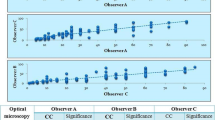Abstract
The proliferative index in breast carcinoma is usually calculated by the percentage of the Ki-67 positive cells out of the total number of malignant cells. In order to reduce the inter-observer variability of the calculated proliferative index a cocktail of antibodies against E-Cadherin and Ki-67 (Ki/Cad Cocktail) is presented. The cocktail was applied on 59 cases of infiltrating duct carcinoma of breast and compared to the consecutive slides stained for Ki-67 alone. The Ki/Cad cocktail has the advantage that by adding the anti E-Cadherin antibody, all the malignant epithelial cells are highlighted and can be differentiated from other proliferating cells. Statistical analysis proved that the cocktail increases the inter-observer agreement from 89 % to 97 % as compared to the Ki-67 alone and also reduces the overlap between the cancer grades.


Similar content being viewed by others
References
DeSantis C, Siegel R, Bandi P, Jemal A (2011) Breast cancer statistics, 2011. CA Cancer J Clin 61:409–418. doi:10.3322/caac.20134
Yerushalmi R, Woods R, Ravdin PM, Hayes MM, Gelmon KA (2010) Ki67 in breast cancer: prognostic and predictive potential. Lancet Oncol 11:174–183
Assersohn L, Salter J, Powles TJ, A’hern R, Makris A, Gregory RK, Chang J, Dowsett M (2003) Studies of the potential utility of Ki67 as a predictive molecular marker of clinical response in primary breast cancer. Breast Cancer Res Treat 82:113–123
Urruticoechea A, Smith IE, Dowsett M (2005) Proliferation marker Ki-67 in early breast cancer. J Clin Oncol 23:7212–7220
Lindboe CF, Torp SH (2002) Comparison of Ki-67 equivalent antibodies. J Clin Pathol 55:467–471
Cooper LS, Gillett CE, Smith P, Fentiman IS, Barnes DM (1998) Cell proliferation measured by MIB1 and timing of surgery for breast cancer. Br J Cancer 77:1502–1507
Thor AD, Liu S, Moore DH 2nd, Edgerton SM (1999) Comparison of mitotic index, in vitro bromodeoxyuridine labeling, and MIB-1 assays to quantitate proliferation in breast cancer. J Clin Oncol 17:470–477
Rudolph P, Alm P, Heidebrecht HJ, Bolte H, Ratjen V, Baldetorp B, Fernö M, Olsson H, Parwaresch R (1999) Immunologic proliferation marker Ki-S2 as prognostic indicator for lymph node-negative breast cancer. J Natl Cancer Inst 91:271–278
Mengel M, von Wasielewski R, Wiese B, Rüdiger T, Müller-Hermelink HK, Kreipe H (2002) Inter-laboratory and inter-observer reproducibility of immunohistochemical assessment of the Ki-67 labelling index in a large multi-centre trial. J Pathol 198:292–299
Dowsett M, Nielsen TO, A’Hern R, Bartlett J, Coombes RC, Cuzick J, Ellis M, Henry NL, Hugh JC, Lively T, McShane L, Paik S, Penault-Llorca F, Prudkin L, Regan M, Salter J, Sotiriou C, Smith IE, Viale G, Zujewski JA, Hayes DF (2011) International Ki-67 in Breast Cancer Working Group. Assessment of Ki67 in breast cancer: recommendations from the International Ki67 in Breast Cancer working group. J Natl Cancer Inst 103:1656–1664
Gal R, Halpern M, Gertzmann H, Schwartz A, Rath-Wolfson L, Koren R (2011) Ki-67 & E-Cadherin cocktail: an immunochemical stain for accurate estimation of the proliferative index in infiltrating duct carcinoma of breast. Med Con 4:9–11
Bland JM, Altman DG (1986) Statistical methods for assessing agreement between two methods of clinical measurement. Lancet 1:307–310
Landis JR, Koch GG (1977) The measurement of observer agreement for categorical data. Biometrics 33:159–174
Yaziji H, Eisen R, Wick M, Badve S, Cartun R, Haas T, Marolt M, Hicks D, Martin A, Barry T, Alsabeh R, Taylor J, Fulton R, Goldsmith J, Shen S, Taylor C, Swanson P (2012) Immunohistochemistry cocktails are here to stay: Center for Medicare and Medicaid Services should revise its new reimbursement policy. Am J Clin Pathol 138:10–11
Orchard G (2002) Evaluation of melanocytic neoplasms: application of a pan-melanoma antibody cocktail. Br J Biomed Sci 59:196–202
Sanderson SO, Sebo TJ, Murphy LM, Neumann R, Slezak J, Cheville JC (2004) An analysis of the p63/alpha-methylacyl coenzyme A racemase immunohistochemical cocktail stain in prostate needle biopsy specimens and tissue microarrays. Am J Clin Pathol 121:220–225
Tacha DE, Miller RT (2004) Use of p63/P504S monoclonal antibody cocktail in immunohistochemical staining of prostate tissue. Appl Immunohistochem Mol Morphol 12:75–78
Hameed O, Sublett J, Humphrey PA (2005) Immunohistochemical stains for p63 and alpha-methylacyl-CoA racemase, versus a cocktail comprising both, in the diagnosis of prostatic carcinoma: a comparison of the immunohistochemical staining of 430 foci in radical prostatectomy and needle biopsy tissues. Am J Surg Pathol 29:579–587
Jiang Z, Li C, Fischer A, Dresser K, Woda BA (2005) Using an AMACR (P504S)/34betaE12/p63 cocktail for the detection of small focal prostate carcinoma in needle biopsy specimens. Am J Clin Pathol 123:231–236
Qureshi HS, Linden MD, Divine G, Raju UB (2006) E-cadherin status in breast cancer correlates with histologic type but does not correlate with established prognostic parameters. Am J Clin Pathol 125:377–385
Acknowledgments
Mrs. Hanna Gertzmann and Mr. Faher Atili for thier technical support.
Author information
Authors and Affiliations
Corresponding author
Rights and permissions
About this article
Cite this article
Bubis, G., Hilly, O., Bubis, R. et al. A New Ki-67 / E-Cadherin Cocktail Reduces Inter-observer Variation of the Calculated Proliferative Index. Pathol. Oncol. Res. 19, 875–879 (2013). https://doi.org/10.1007/s12253-013-9655-8
Received:
Accepted:
Published:
Issue Date:
DOI: https://doi.org/10.1007/s12253-013-9655-8




